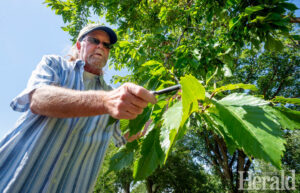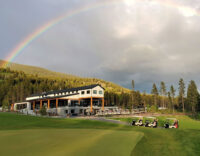Dutch Elm Disease still a concern for City
By Tim Kalinowski on June 10, 2021.
 City urban forestry technician Lindsay Bell points out some of the features of an elm tree in a northside park in 2020 after forestry staff confirmed two trees were discovered to be infected with Dutch Elm Disease.
Herald file photo by Ian Martens
City urban forestry technician Lindsay Bell points out some of the features of an elm tree in a northside park in 2020 after forestry staff confirmed two trees were discovered to be infected with Dutch Elm Disease.
Herald file photo by Ian MartensLETHBRIDGE HERALDtkalinowski@lethbridgeherald.com
Dutch Elm Disease remains a concern in the city, the Civic Works Standing Policy Committee of city council was told during this week’s public meeting, and the City will be stepping up its inspection and education efforts to help prevent further spread of the disease.
Last year Lethbridge became the first community in Alberta placed under a Dutch Elm Disease (DED) alert after two cases were discovered in public trees on the northside. So far no new cases have been identified this year; however, City of Lethbridge Parks operations manager Hiroshi Okubo told the Civic Works SPC his department would be assigning two seasonal employees to inspect all the City’s 6,000 public elm trees.
He also said the department would be seeking cooperation from private property owners for the City to do the same types of inspections on their elm trees.
“We are planning to complete a private tree inventory of inspections,” confirmed Okubo. “We have under consideration bringing forward a Dutch Elm Disease bylaw, similar to what other communities have done. For those municipalities that don’t have a bylaw, such as ourselves, the (Agricultural Pests Act) provides for a means of enforcement where it is an offense not to take active measures, and not to follow an inspector’s notice which can be issued by a number of different authorities.”
With or without a local bylaw in place, Okubo confirmed the Parks department would be accessing these additional powers for its inspectors to track down any potential sources or cases of Dutch Elm Disease in the community, whether on private or public lands.
“They will have the powers and responsibilities outlined in the (APA) to enforce Dutch Elm Disease prevention and control measures to the landowner,” he said.
Right now, said Okubo, a key priority for Parks staff is completing the private tree inventory.
“Our plan is to set this up under the Parks department while still utilizing bylaw enforcement’s expertise and assistance when required,” he explained. “Our inspectors, armed with our education program, will be able to work with our citizens to inspect private trees and to search for stored elmwood, which we believe may have been the cause of the two cases here.”
However, acknowledged Okubo, it is also up to the City to educate landowners on DED, and to encourage them to take proper care of their elm trees to keep them healthy, and thus less susceptible to the disease.
“We need to educate our community about Dutch Elm Disease,” he stated. “It’s not just about communicating by public service announcements or notices. It has to be a concentrated effort to educate our community on Dutch Elm Disease.”
Something as simple as the regular watering of trees on a landowner’s property can make an immense difference, stated Okubo.
“If we don’t look after our trees, they don’t have their own natural responses to try to fight off a disease. If we keep them as healthy as we can, then they have a chance. In Lethbridge, we’re in a desert with irrigation, and that’s the only thing that helps our trees survive.”
Follow @TimKalHerald on Twitter
4-3




